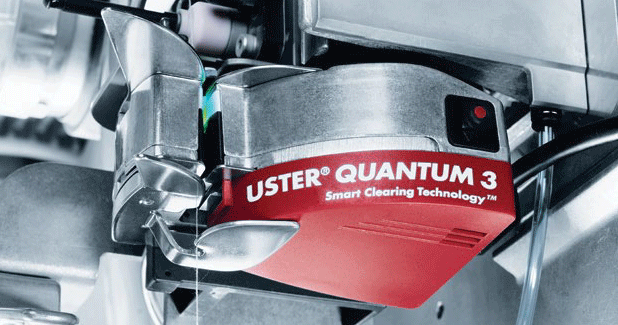
Key quality parameters: A practical challenge
Ambitious yarn spinners quickly learn that key performance indicators are closely linked with quality ´ especially at the higher levels of the market, as an example from China shows. Achieving consistent quality, reducing waste and avoiding the risk of packages ruined by outliers are critical objectives, attainable only by implementing systematic quality management.
Top-end Chinese spinner puts yarn clearers to the test.
Ambitious yarn spinners quickly learn that key performance indicators are closely linked with quality ´ especially at the higher levels of the market, as an example from China shows. Achieving consistent quality, reducing waste and avoiding the risk of packages ruined by outliers are critical objectives, attainable only by implementing systematic quality management. The USTER® QUANTUM 3 clearers provide the ideal basis for this, with in-process yarn optimisation, proven by stringent mill trials and confirmed by laboratory checks.
Chinese spinner Shandong Liaocheng Huarun Textile aims firmly at the top segment of the yarn business, with its focus on super-fine counts made from combed long-staple cottons. The mill´part of the Huarun Group´is established among China´s leading producers, exporting 50 per cent of its output to Europe.
Reaching this level is tough, staying there even tougher, demanding constant effort to monitor and optimise quality and productivity. That includes choosing the best-available equipment as part of the ideal recipe for success. Against this background, Liaocheng Huarun decided to run a comprehensive practical trial to identify the best yarn clearer to meet its challenging quality and cost goals.
The USTER® QUANTUM 3 clearer is known as the preferred choice for many spinning mills producing fine and very fine count yarns for demanding applications such as high-quality woven fabrics. That meant that Liaocheng Huarun had high expectations of the USTER® instrument when comparing it with existing clearers for controlling yarn faults.
Proven: better quality, lower waste
In the trial, the USTER® clearers were installed on 60 spindles, matched against a competitive brand clearer on similar automatic winders. After a month, the mill assessed the trial results from cuts and remaining faults, using the USTER® CLASSIMAT. This showed that the USTER® QUANTUM 3 left 50 per cent fewer disturbing thick and thin places in the yarn, with 13 per cent fewer cuts per 100 kilometers (see www.uster.com/quantumhuarun for detailed trial results). The overall verdict was that USTER® QUANTUM 3 had proved its ability to deliver better quality and less waste, enhancing the optimisation potential of the mill.
Modern quality demands not only call for a perfectly cleared yarn suited to the end-use, but must also take in the fact that only a few outlier bobbins can spoil many meters of fabric, resulting in expensive claims. Devising a system to avoid such issues was another key objective of Liaocheng Huarun in running the clearer trials. The USTER® QUANTUM 3 measures yarn quality parameters including CV, imperfections and hairiness, using the Q Data feature, correlated with USTER® TESTER data. These controls allow Liaocheng Huarun to meet its goal of managing outliers in the final yarn package. In the trial, outlier bobbins collected from winding were checked again in the laboratory, using the USTER® TESTER. The laboratory tests confirmed the accuracy of the clearers in identifying these outliers. This systematic quality management, using the Q Data feature of the USTER® QUANTUM 3, means outlier bobbins are no longer a serious risk.
Key performance and quality indicators
Thomas Nasiou, Head of Textile Technology within USTER says: ´For spinners aiming at consistently high standards of yarn quality, systematic quality management is essential. We strongly recommend it as a general policy, since it is the best way to achieve both optimum quality and homogeneity of quality between and within yarn lots.´
Key Performance Indicators (KPI) are used to set the yarn quality at the right level. Especially at the end of the production process, KPIs are essential because they have a direct impa




